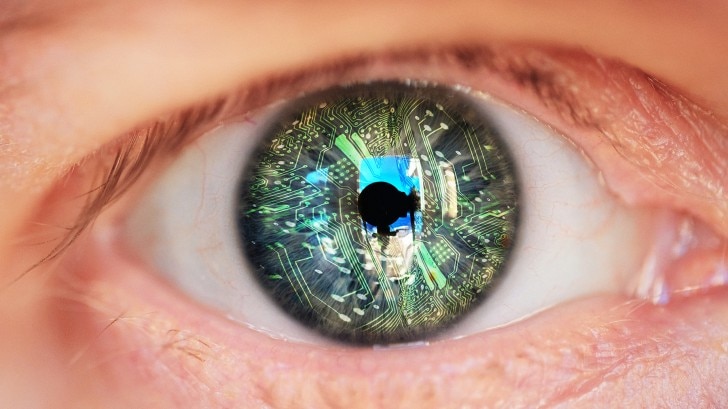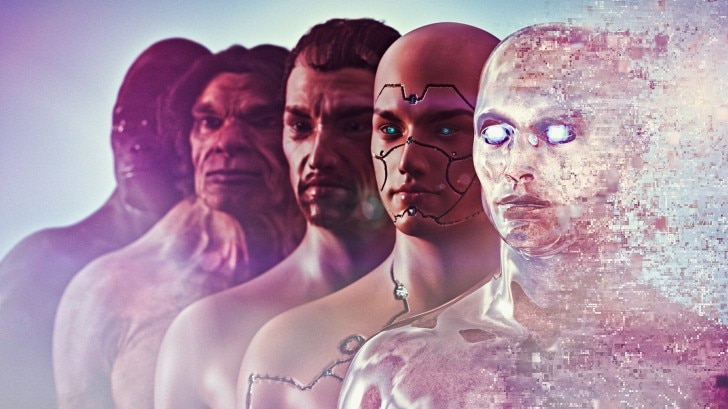What will humans look like in a million years?
What will humans look like in a million years?
To understand our future evolution we need to look to our past.
Will our descendants be cyborgs with hi-tech machine implants, regrowable limbs and cameras for eyes like something out of a science fiction novel?
Might humans morph into a hybrid species of biological and artificial beings? Or could we become smaller or taller, thinner or fatter, or even with different facial features and skin colour?
Of course, we don’t know, but to consider the question, let’s scoot back a million years to see what humans looked like then. For a start, Homo sapiens didn’t exist. A million years ago, there were probably a few different species of humans around, including Homo heidelbergensis, which shared similarities with both Homo erectus and modern humans, but more primitive anatomy than the later Neanderthal.
Over more recent history, during the last 10,000 years, there have been significant changes for humans to adapt to. Agricultural living and plentiful food have led to health problems that we’ve used science to solve, such as treating diabetes with insulin. In terms of looks, humans have become fatter and, in some areas, taller.
ARTICLE CONTINUES BELOW
MORE ON SCIENCE
Minecraft x Frozen Planet II
The Unexpected World of Pluto
Are vitamin pills worth the money?
ADVERTISEMENT
Perhaps, then, we could evolve to be smaller so our bodies would need less energy, suggests Thomas Mailund, Senior Lecturer in Bioinformatics and Big Data at Anglia Ruskin University, London, which would be handy on a highly-populated planet.
Living alongside lots of people is a new condition humans have to adapt to. Back when we were hunter gatherers, there would’ve been a handful of interactions on a daily basis. Mailund suggests we may evolve in ways that help us to deal with this. Remembering people’s names, for example, could become a much more important skill.
Here’s where the technology comes in. “An implant in the brain would allow us to remember people’s names,” says Thomas. “We know what genes are involved in building a brain that’s good at remembering people’s names. We might just change that. It sounds more like science fiction. But we can do that right now. We can implant it but we don’t know how to wire it up to make it useful. We’re getting there but it’s very experimental.”
We know what genes are involved in building a brain that’s good at remembering people’s names. We might just change that."
Thomas Mailund
ASSOCIATE PROFESSOR IN BIOINFORMATICS
 Will our descendants be cyborgs? © Daniel Haug | Getty
Will our descendants be cyborgs? © Daniel Haug | Getty
“It’s not really a biological question anymore, it’s technological,” he said.
Currently, people have implants to fix an element of the body that’s broken, such as a pacemaker or a hip implant. Perhaps in the future, implants will be used simply to improve a person. As well as brain implants, we might have more visible parts of technology as an element of our appearance, such an artificial eye with a camera that can read different frequencies of colour and visuals.
We’ve all heard of designer babies. Scientists already have the technology to change the genes of an embryo, though it’s controversial and no one’s sure what happens next. But in the future, Mailund suggests, it may be seen as unethical not to change certain genes. With that may come choice about a baby’s features, so perhaps humans will look like what their parents want them to look like.
“It’s still going to be selection, it’s just artificial selection now. What we do with breeds of dogs, we’ll do with humans,” said Mailun.
This is all rather hypothetical, but can demographic trends give us any sense of what we may look like in the future? Will technology affect our evolution? © Donald Iain Smith | Getty
Will technology affect our evolution? © Donald Iain Smith | Getty
Predicting out a million years is pure speculation, but predicting into the more immediate future is certainly possible using bioinformatics..."
Dr. Jason A. Hodgson
LECTURER IN GRAND CHALLENGES IN ECOSYSTEMS AND THE ENVIRONMENT
“Predicting out a million years is pure speculation, but predicting into the more immediate future is certainly possible using bioinformatics by combining what is known about genetic variation now with models of demographic change going forward,” says Dr. Jason A. Hodgson, Lecturer, Grand Challenges in Ecosystems and the Environment.
Now we have genetic samples of complete genomes from humans around the world, geneticists are getting a better understanding of genetic variation and how it’s structured in a human population. We can’t exactly predict how genetic variation will change, but scientists in the field of bioinformatics are looking to demographic trends to give us some idea.
Hodgson predicts urban and rural areas will become increasingly genetically diverse. “All the migration comes from rural areas into cities so you get an increase in genetic diversity in cities and a decrease in rural areas,” he said. “What you might see is differentiation along lines where people live.” Genetic diversity will increase in cities and decrease in rural areas © Ryan Deberardinis/EyeEm | Getty
Genetic diversity will increase in cities and decrease in rural areas © Ryan Deberardinis/EyeEm | Getty
It will vary across the world but in the UK, for example, rural areas are less diverse and have more ancestry that’s been in Britain for a longer period of time compared with urban areas which have a higher population of migrants.
Some groups are reproducing at higher or lower rates. Populations in Africa, for example, are rapidly expanding so those genes increase at a higher frequency on a global population level. Areas of light skin colour are reproducing at lower rates. Therefore, Hodgson predicts, skin colour from a global perspective will get darker.
“It’s almost certainly the case that dark skin colour is increasing in frequency on a global scale relative to light skin colour,” he said. “I’d expect that the average person several generations out from now will have darker skin colour than they do now.”
And what about space? If humans do end up colonising Mars, what would we evolve to look like? With lower gravity, the muscles of our bodies could change structure. Perhaps we will have longer arms and legs. In a colder, Ice-Age type climate, could we even become even chubbier, with insulating body hair, like our Neanderthal relatives?
We don’t know, but, certainly, human genetic variation is increasing. Worldwide there are roughly two new mutations for every one of the 3.5 billion base pairs in the human genome every year, says Hodgson. Which is pretty amazing - and makes it unlikely we will look the same in a million years.








![[ℕ𝕖𝕧𝕖𝕣] 𝕊𝕖𝕝𝕝 𝕐𝕠𝕦𝕣 𝔹𝕚𝕥𝕔𝕠𝕚𝕟 - And Now What.... Pray To The God Of Hopium?](https://cdn.bulbapp.io/frontend/images/79e7827b-c644-4853-b048-a9601a8a8da7/1)

























